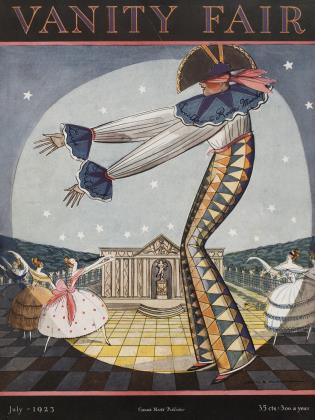Sign In to Your Account
Subscribers have complete access to the archive.
Sign In Not a Subscriber?Join NowNovelties of European Motor Car Design
A Few Coach Builders Forsake the Beaten Track in Body Lines and Features
C. S. BISS
WHILE it is true that motoring Europe is paying special attention to small, light, economical cars for the average owner, and diminutive but luxurious town cars for the more wealthy, many custom built cars are appearing which have nothing to do with this Lilliputian tendency. It is still possible to journey around among the coach builders' shops and discover, here and there, a car which fairly takes one's breath away with the richness of its fittings and the daring of its lines.
One of the most interesting motor cars 1 have seen lately is the Vanden Plas touring car shown at the top of this page. It is mounted on the Minerva six-cylinder chassis and is styled a "torpedo". Its top is of the disappearing variety and goes out of sight into a properly shaped compartment around the rear seat. If you will look closely, you will see that the panels which cover this compartment are part of the top itself and are raised with it until they reach a position where they may be attached to the windshield. I don't altogether like the rear profile of this car, but that is a purely personal opinion. It has an amazing lighting equipment, including headlamps and three pairs of side lights. The latter are mounted on the front and rear mud guards and on the cowl. There is also a spotlight on the right side of the windshield and a tail light. The steel mesh running boards form a rather neat feature of this car.
(Continued on page 104)
(Continued from page 75)
An enclosed car. which departs considerably from ordinary design, is the Vauxhall pictured on the first page of this article. In America you would call this a sedan. Here we call it a sporting fourseater saloon. Note the odd shape of its windows and rear construction. The chassis is the latest 23-60 h.p. Vauxhall and the body was built by Mullingar. It is designed to carry four people but a large dickey seat will accommodate a fifth passenger. The exterior is finished in a light Quaker gray. The upholstery is a light gray Bedford cord and all the interior woodwork is of polished walnut. This is really a beautiful car, out of the ordinary in appearance and special features, despite the fact that it may exceed the conservatism of the average motor car and find no favor with those to whom conspicuousness is a bete noire.
A very interesting new type of car has recently been produced by Gill on the Wolseley chassis. I presume you would call this a limousine-cabriolet. In the ordinary limousine-landaulet, only the rear portion of the roof is made to fold down. In this Gill car the entire roof, from the rear of the driver's compartment, is collapsible, thus allowing the whole of tile passenger compartment to be opened up for.fair weather driving. The rear portion of the top opens in exactly the same way as the ordinary landaulet, and when in the "down" position, it lies very flat. The window behind the driver's seat is curved and forms an excellent wind screen for the passengers when the car is opened up. The side windows are made to disappear by the use of small revolving handles.
A number of European built bodies are being placed upon the better American chassis over here. One of these is shown herewith, a very interesting machine, a sedan - limousine - cabriolet by Barker, mounted on the Packard Single Sixchassis. Its clumsy name comes from the fact that it has the characteristics of a sedan, a limousine and a cabriolet. It is, really, in the closed position, a sedan, but it has a movable window behind the driver which makes it a sedan-limousine. The fact that the entire top is collapsible brings it into the cabriolet class, hence the awkward, but necessary, length of its designation. 1 ' Note XT ' particularly on this car the absence of exterior bows on the rear quarter. Other points worth more than a passing glance are the very thin front corner pillars, the divided windshield, the tool box under the running board, the polished aluminum hood and cowl and the wheels, which are Barker discs placed over regular artillery wheels,
Among the new sport cars is a cloverleaf roadster built by Morgan on the 12 h.p. A. B. C. chassis. Two pictures of this car are shown. At either side of the rear seat, lockers are built into the body which are spacious enough to carry a large can of oil on one side, and all the heavy tools and a can of petrol on the other. Another locker, large enough to hold a substantial suitcase, is provided behind the top. A small compartment accommodates the side curtains, which are supplied to make this an all-weather car. The construction is of real English bone dry ash and the paneling is in aluminum.
Great success is predicted for this year's racing, both in America and in Europe. By this time your famous classic, the Infernational Sweepstake at Indianapolis, will be over and you will know of the tremendous interest taken in that event by European manufacturers and drivers, including some of the nobility. The next important event will be the French Grand Prix early in July, an exciting contest of a highly international character over a course near the ancient city of Tours.
 View Full Issue
View Full Issue






Subscribers have complete access to the archive.
Sign In Not a Subscriber?Join Now